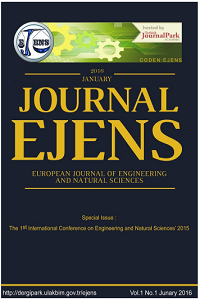Chelate-Induced Phytoextraction Potential of Brassica rapa for Soil Contaminated with Nickel
Chelate-Induced Phytoextraction Potential of Brassica rapa for Soil Contaminated with Nickel
Brassica rapa, EDTA, Hyperaccumulator Nickel,
___
- [1]. S. P. McGrath, E. Lombi, C. W. Gray, N. Calille, S. J. Dunham and F. J. Zhao, Field evaluation of Cd and Zn phytoextraction potential by the hyperaccumulators Thlaspi caerulescensand Arabidopsis halleri. Environ Poll 141:15-125, 2006.
- [2]. C. Chen, D. Huang and J. Liu, Functions and toxicity of nickel in plants: recent advances and future prospects. Clean 37:304–313, 2009.
- [3]. I.E. Akinci and U. Caliskan Effect of Lead on Seed Germination and Tolerance Levels in Some Summer Vegetables. Ecology 19(74): 164-172, 2010.
- [4]. M. S. Abdullahi, A. Uzairu , G. F. S. Harrison, M. L. Balaraabe and O. J. Okunola, Comparative study of tomatoes and onions from irrigated farmlands on the bank of river Challawa, kano, Nigeria. Int J Environ Res 2(1): 65- 70, 2007.
- [5]. M. S. Abdullahi, A. Uzairu and O. J. Okunola, Quantitative determination of heavy metal concentration in onion leaves. Int J Environ Res 3(2): 271-274, 2009.
- [6]. D. Muhammad, F. Chen, J. Zhao, G. Zhang and F. Wu, Comparison of EDTA- and citric acid-enhanced phytoextraction of heavy metals in artificially metal contaminated soil by Typha angustifolia. Int J Phytoremediat 11(6): 558-574, 2009.
- [7]. G. Garg and S. .K. Kataria, Phytoremediation potential of Raphanus sativus (L.), Brassica juncea (L.) and Triticum aestivum (L.) for copper contaminated soil. E-Proceedings of International Society of System Sciences, Univertity of Queensland, Brisbane (Australia), July 12-17, 2010.
- [8]. S. Greipsson, Phytoremediation. Nature Education Knowledge, 2(1): 7, 2011.
- [9]. D. Aydin and O. F. Coskun, Effects of EDTA on Cr+3 Uptake, Accumulation, and Biomass in Nasturtium officinale (Watercress). Ecology 22 (87): 16-23, 2013.
- [10]. J. W. Huang, J. J. Chen, W. R. Berti and S. D. Cunningham, Phytoremediation of lead contaminated soils: role of synthetic chelates in lead phytoextraction. Environ Sci Technol 31:800–805, 1997.
- Başlangıç: 2015
- Yayıncı: CNR Çevre
Enhancing Heat Transfer from a Porous Plate with Transpiration Cooling
Prediction of Dam Reservoir Volume Fluctuations Using Adaptive Neuro Fuzzy Approach
Moving Object Detection Using an Adaptive Background Modeling in Dynamic Scene
Nonlinear Buckling Analysis of Cold-Formed Channel Sections
Diagnosis of Coronary Artery Disease Using Deep Belief Networks
Biodiesel Production Using Wet and Dry Purification Methods
Investigation and Evaluation of Degradability of Ibuprofen from Wastewater by Using Fenton Process
